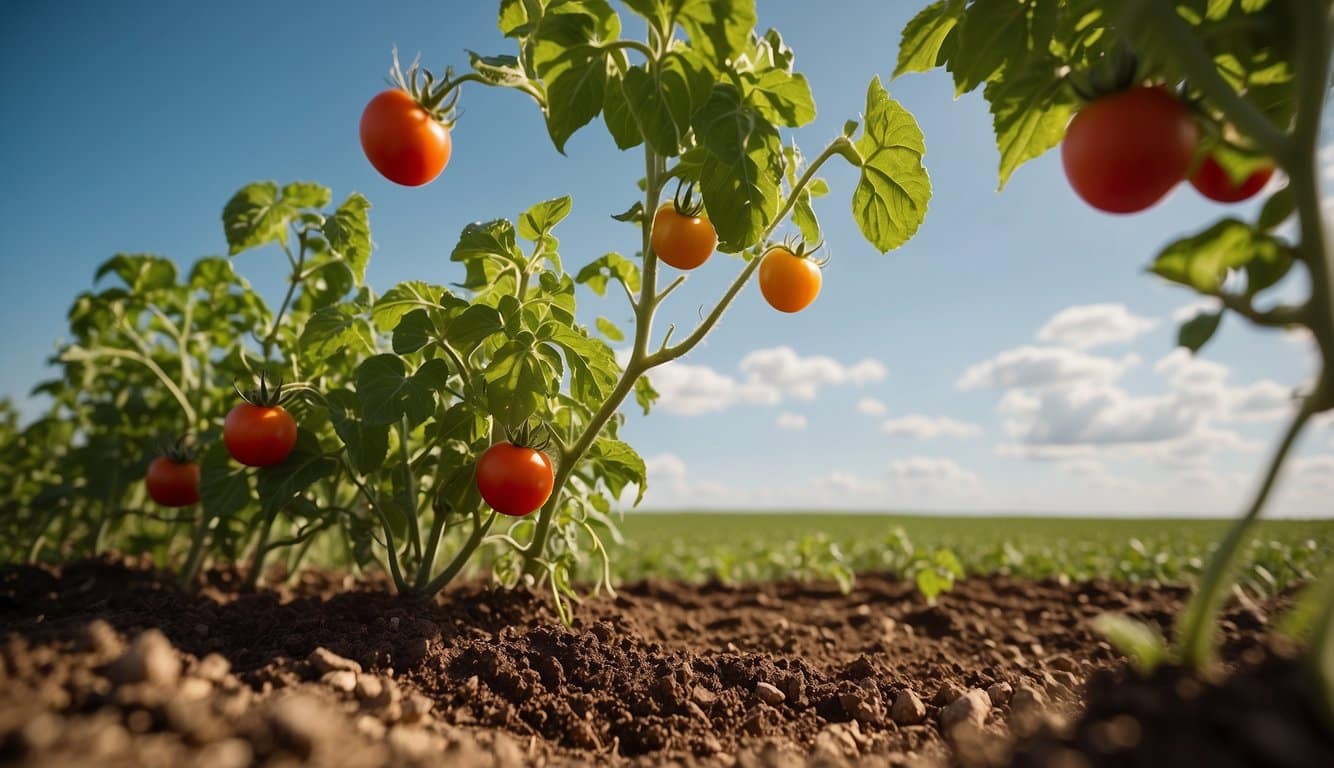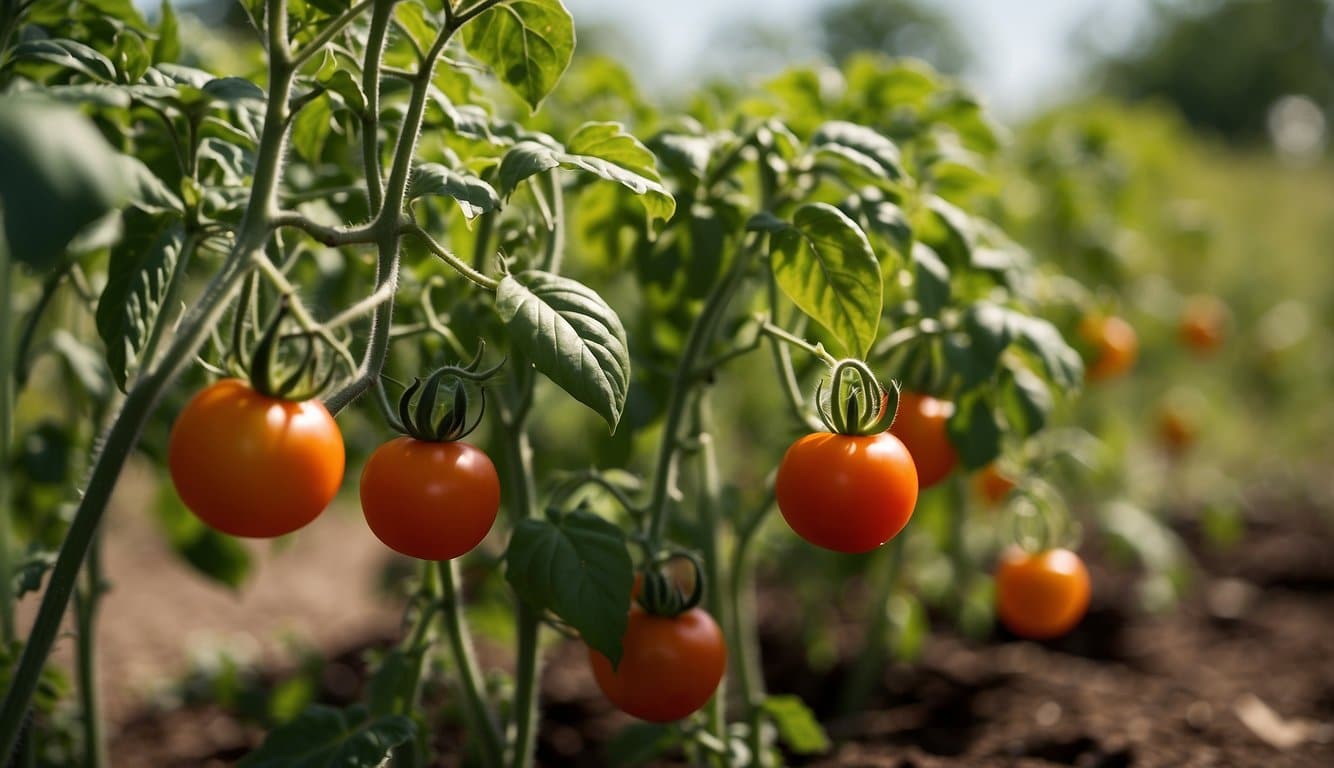| Question | What’s the best time of year to plant tomatoes in Kansas? |
|---|---|
| Answer | After the last spring frost, typically late April to early May. |
| More Info |
|

Kansas gardeners benefit from starting tomato seeds indoors approximately 6-8 weeks before the planned outdoor planting date.
This approach allows the plants to be sufficiently mature and strong when transplanted outside. Given Kansas’s varied climate, checking local frost dates and adjusting planting times accordingly is crucial for success.
Kansas is known for its hot summers and cold winters, which can make it a challenge to grow certain crops. However, with the right knowledge and preparation, it is possible to grow delicious and healthy tomatoes in Kansas.
One of the most important factors to consider when planting tomatoes is the timing. Knowing the best time of year to plant tomatoes in Kansas can help ensure a successful harvest.
Key Takeaways
- To grow tomatoes successfully in Kansas, it is important to understand the state’s climate and soil conditions.
- The best time to plant tomatoes in Kansas is during the warm months, usually between late April and early May.
- Planting time may vary depending on the location, so it is important to check local weather and soil conditions before planting.
Understanding Kansas Climate for Tomato Planting
Kansas has a humid continental climate with hot summers and mild winters, which is ideal for growing tomatoes. The soil in Kansas is typically loamy, well-draining, and rich in organic matter, providing a nurturing environment for tomato plants.
However, it is important to note that Kansas experiences a wide range of temperatures and weather patterns throughout the year, which can impact the success of tomato planting.
The state is prone to severe weather conditions such as thunderstorms, tornadoes, and hailstorms, which can damage or destroy tomato plants.
To ensure the best possible outcome for tomato planting in Kansas, it is essential to understand the climate and weather patterns of the region.
The following table provides an overview of the average temperature and precipitation levels in Kansas throughout the year:
| Month | Average Temperature (°F) | Average Precipitation (inches) |
|---|---|---|
| January | 28 | 0.75 |
| February | 33 | 0.95 |
| March | 43 | 2.15 |
| April | 54 | 3.15 |
| May | 64 | 4.45 |
| June | 74 | 4.70 |
| July | 79 | 3.70 |
| August | 77 | 3.30 |
| September | 69 | 3.10 |
| October | 57 | 2.40 |
| November | 42 | 1.30 |
| December | 31 | 0.90 |
As shown in the table, the average temperature in Kansas ranges from 28°F in January to 79°F in July, with an average precipitation level of 3.09 inches per month.
The temperature and precipitation levels can vary significantly from year to year, so it is important to monitor weather forecasts and adjust planting schedules accordingly.
In general, the best time to plant tomatoes in Kansas is in late April or early May, after the last frost has passed. This allows the plants to mature during the warm summer months and produce a bountiful harvest in the fall.
However, it is important to monitor weather conditions and adjust planting schedules as needed to ensure the best possible outcome for tomato planting in Kansas.
Optimal Planting Times for Tomatoes in Kansas
When it comes to planting tomatoes in Kansas, timing is everything. The right planting time can make all the difference in the success of your tomato crop.
Here are some guidelines to help you determine the optimal planting times for tomatoes in Kansas.
Spring Planting Guidelines
Spring is the most popular time of year to plant tomatoes in Kansas. The ideal time to plant tomatoes outdoors is after the last frost date has passed.
In Kansas, the last frost date typically falls between late April and early May, depending on your location. To ensure that your tomato plants have enough time to mature before the first fall frost, it’s recommended to plant them by June 1st.
If you plan to start your tomato seeds indoors, you should begin the process approximately six to eight weeks before the last frost date.
This will give your seedlings enough time to grow and develop before they are transplanted outdoors.
When transplanting your seedlings, make sure to space them at least 2 feet apart to allow for adequate air circulation and prevent the spread of disease.
Fall Planting Considerations
While spring is the most popular time to plant tomatoes in Kansas, fall planting can also be successful. Fall planting allows you to extend your growing season and harvest fresh tomatoes well into the autumn months.
The ideal time to plant fall tomatoes is in late July or early August, approximately 10 to 12 weeks before the first fall frost.
When planting fall tomatoes, it’s important to choose varieties that have a shorter maturity time, typically around 60 to 70 days. This will allow your plants to mature before the first fall frost.
You should also consider using a protective cover, such as a hoop house or row cover, to help extend your growing season and protect your plants from cooler temperatures.
Site Preparation and Soil Requirements
Before planting tomatoes in Kansas, one must prepare the site and ensure the soil meets the requirements. Proper preparation can significantly impact the success of tomato plants.
Tomatoes prefer well-draining soil with a pH between 6.0 and 6.8. It is recommended to test the soil before planting to ensure it meets these requirements.
If the soil pH is too low, it can be raised by adding lime, while sulfur can be used to lower it if it is too high.
In addition to pH, the soil should be rich in nutrients and organic matter. Adding compost or manure to the soil can improve its fertility and structure, which can lead to healthier and more productive tomato plants.
It is also important to choose a site that receives full sun for at least 6-8 hours a day.
Tomatoes require plenty of sunlight to grow and ripen properly. A location that is sheltered from strong winds can also help protect the plants from damage.
Tomato Varieties Best Suited for Kansas
When choosing the right tomato varieties for Kansas, there are a few things to consider. Kansas has a hot and dry climate, which can be challenging for growing tomatoes. However, with the right varieties, it is possible to grow delicious tomatoes in Kansas.
Indeterminate Varieties
Indeterminate varieties are a great choice for Kansas because they keep growing and producing fruit throughout the growing season. This means that you can enjoy fresh tomatoes from your garden for a longer period of time. Some popular indeterminate varieties for Kansas include:
- Celebrity
- Early Girl
- Better Boy
Determinate Varieties
Determinate varieties are another option for Kansas gardeners. These varieties stop growing at a certain height and produce all of their fruit at once. This can be beneficial if you want to harvest all of your tomatoes at the same time. Some popular determinate varieties for Kansas include:
- Roma
- San Marzano
- Bush Early Girl
Heirloom Varieties
Heirloom varieties are an excellent choice for Kansas gardeners who want to try something new and unique. These varieties have been passed down through generations and often have a distinctive flavor and appearance. Some popular heirloom varieties for Kansas include:
- Brandywine
- Cherokee Purple
- Mortgage Lifter
Frequently Asked Questions
What is the optimal planting date for tomatoes in Kansas?
The optimal planting date for tomatoes in Kansas is generally in mid-May, after the last frost date has passed. However, this can vary depending on the specific location in Kansas and the type of tomato being planted.
It is recommended to consult with local gardening experts or extension offices for more specific guidance.
How does the Kansas climate affect tomato planting schedules?
The Kansas climate can have a significant impact on tomato planting schedules. The state experiences hot summers and cold winters, which can affect the growth and development of tomato plants.
It is important to choose the right tomato varieties that are adapted to the local climate and to plant them at the appropriate time to ensure optimal growth and yield.
What are the recommended tomato varieties for Kansas gardeners?
Kansas gardeners are recommended to choose tomato varieties that are well-suited to the local climate and growing conditions.
Some popular varieties for Kansas include Early Girl, Celebrity, and Cherokee Purple. It is also important to consider factors such as disease resistance, yield potential, and flavor when selecting tomato varieties.
How do Kansas frost dates impact tomato planting?
Kansas frost dates can have a significant impact on tomato planting schedules.
It is important to wait until after the last frost date to plant tomatoes to avoid damage to the plants. Gardeners can consult local resources to determine the average last frost date in their area and plan their planting schedule accordingly.
Can you provide a month-by-month guide for planting tomatoes in Kansas?
While the optimal planting time for tomatoes in Kansas is generally in mid-May, gardeners can begin preparing for planting earlier in the year.
In February and March, tomato seeds can be started indoors to give them a head start before transplanting them to the garden.
In April, gardeners can begin preparing the soil and selecting tomato varieties.
What are the last safe planting dates for tomatoes in Kansas?
The last safe planting dates for tomatoes in Kansas can vary depending on the specific location and climate.
Generally, it is recommended to plant tomatoes no later than mid-June to ensure that they have enough time to mature and produce fruit before the first frost in the fall.
Gardeners can consult local resources for more specific guidance on planting schedules and frost dates.
Last update on 2025-06-06 / Affiliate links / Images from Amazon Product Advertising API







